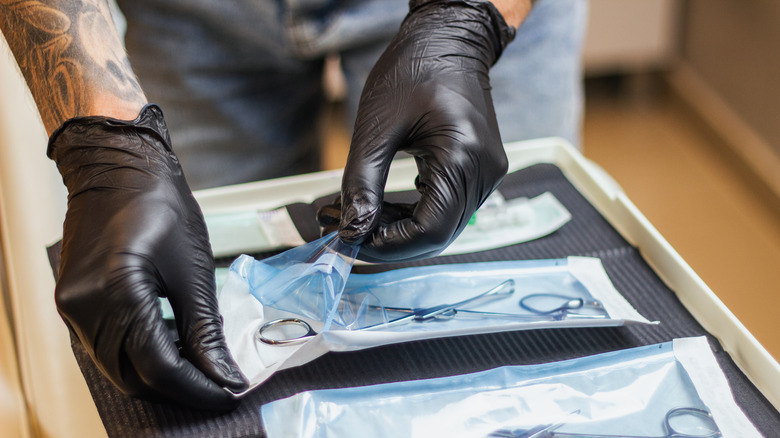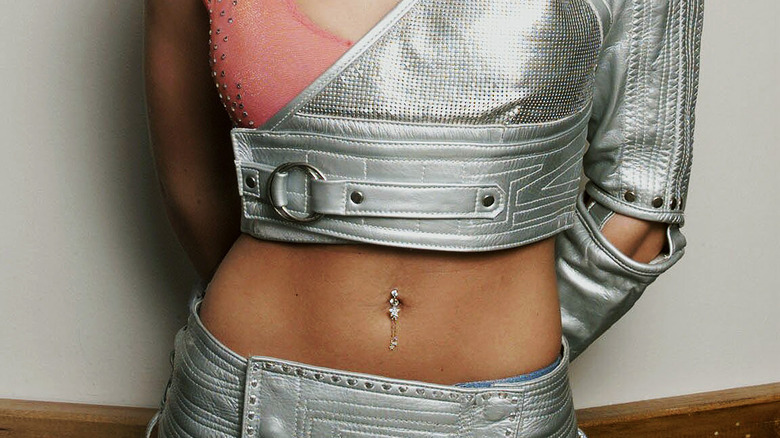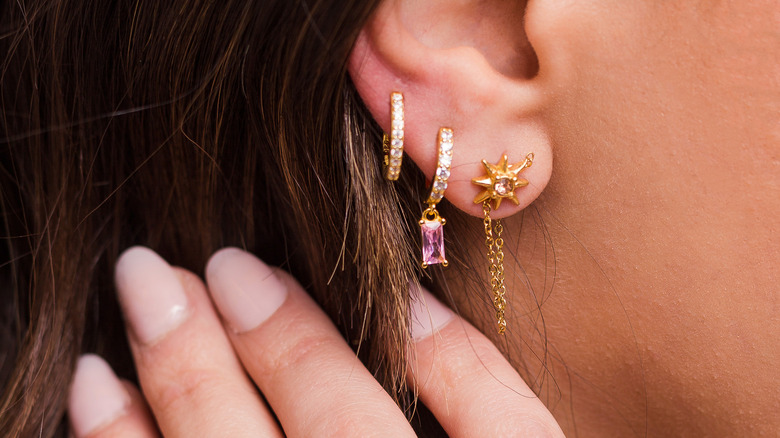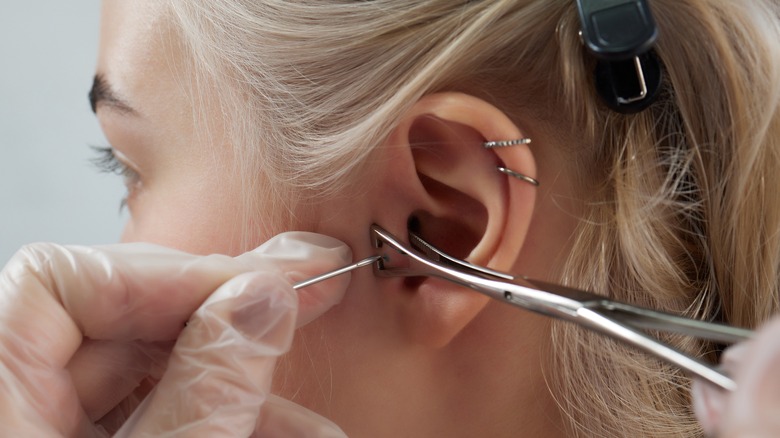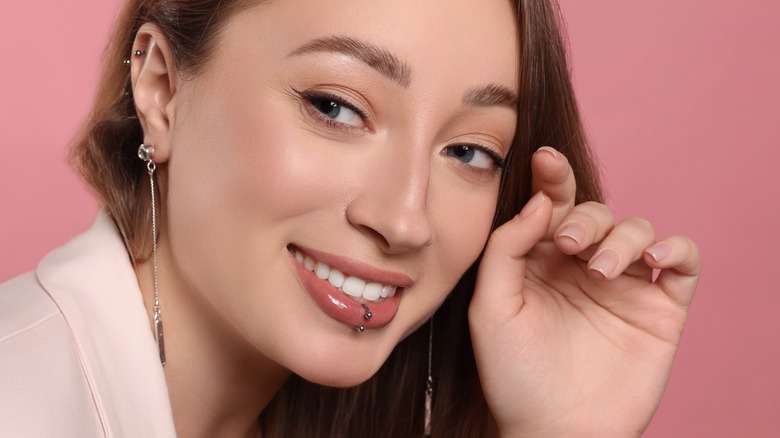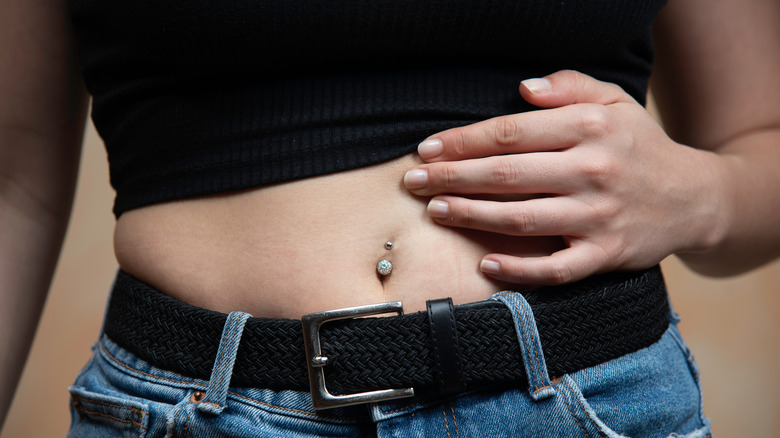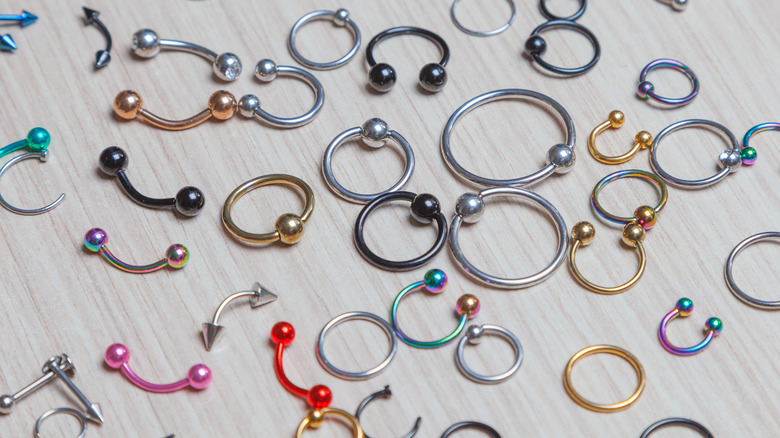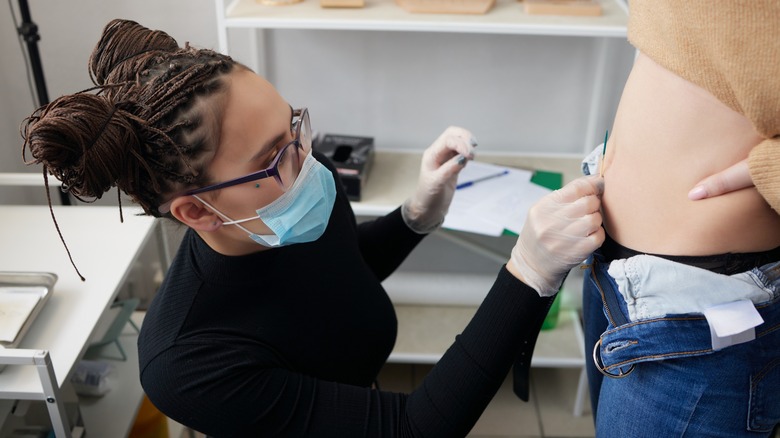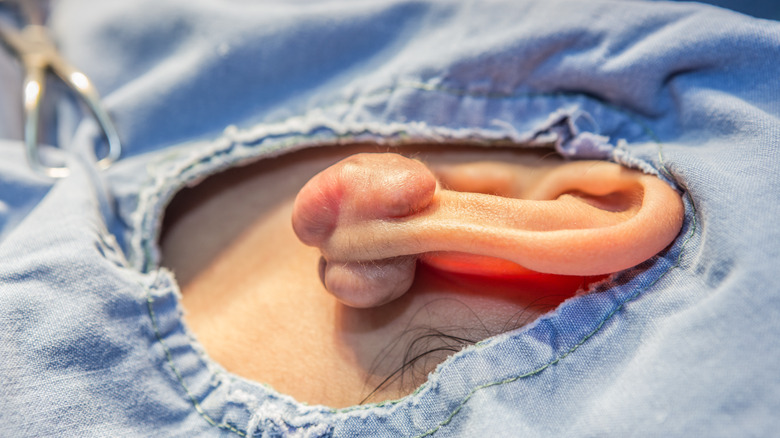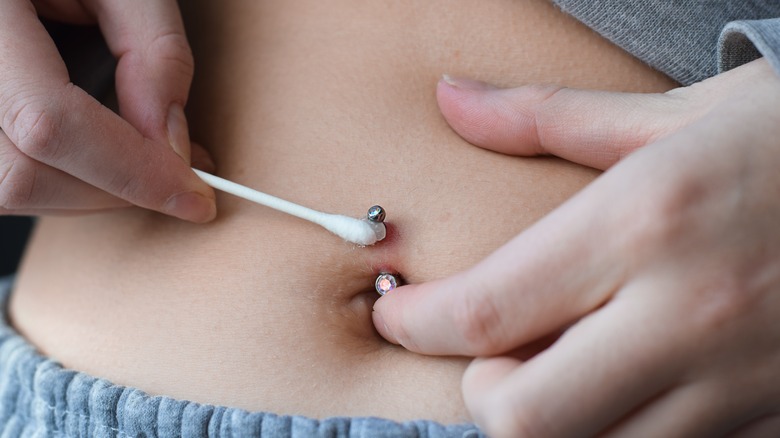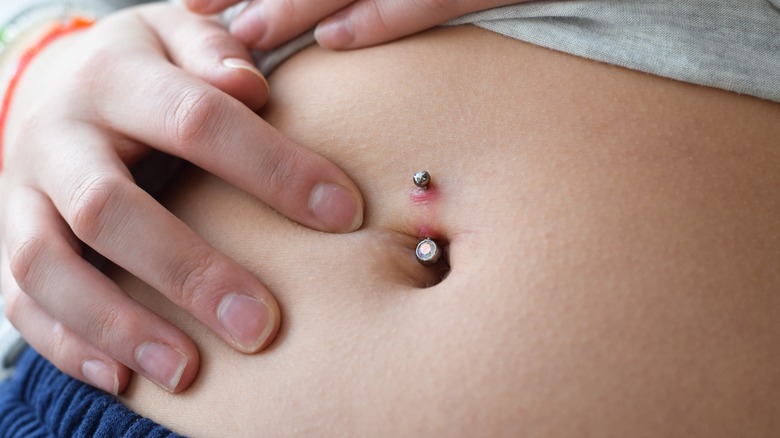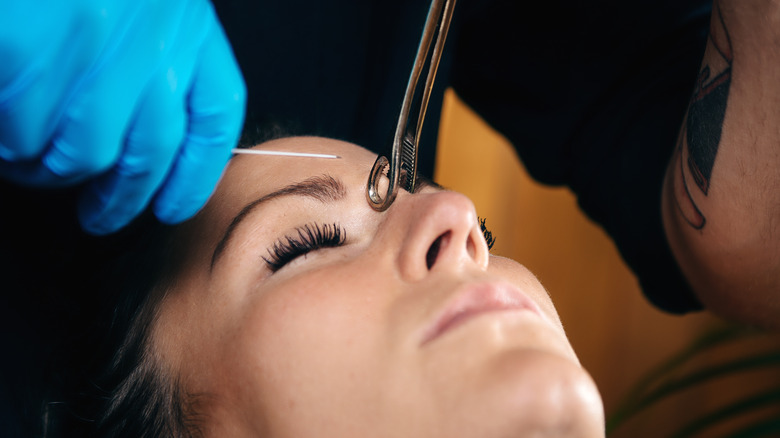The Ultimate Guide To Body Piercings
Body piercing, the practice of making holes in the skin and cartilage and putting in jewelry for decorative purposes, is believed to be as old as modern humanity. According to the Encyclopedia.com, bodies and artifacts from the ninth century before the common era (B.C.E.) suggest that body piercings were common during that time. Additionally, the "Ice Man," the oldest complete human body ever discovered, had gauged earlobes, proving that this practice dates back to at least 5,300 B.C.E. Indigenous cultures all over the globe have practiced some form of body piercing for centuries.
Ear and nose piercings were common on nearly every continent and gauging — stretching earlobe piercings with progressively larger jewelry or weights — was popular in Africa, Asia, and Central America. Lip piercings were less common than ear or nose piercings, but they were still popular in several areas across the globe.
Today, body piercing is more popular than ever before, per the Pew Research Center. Though body piercing used to be a counterculture associated with high-risk behaviors, the American Academy of Pediatrics states that body piercings have gone mainstream. Whether you've already been pierced or you're thinking about getting your first one and are interested in what happens to your body when you get a piercing, this guide will give you all the information you need.
Reasons people get body piercings
Throughout history, people have chosen to get body piercings for myriad reasons. According to a comprehensive paper on the history and modern practice of body piercings published in The Lancet, many indigenous cultures practiced body piercing as part of important rituals and rites of passage. Piercings were also common as a status symbol, either of wealth, leadership, or religious importance.
In the 1970s and '80s in Europe and the United States, body piercings rose to popularity in the punk subculture. Punks pierced their body as a visual rebellion against the mainstream culture meant to provoke those adhering to the status quo of the time. Getting pierced as a form of rebellion and a rejection of the mainstream has continued to be a primary motivation for getting piercings in places other than in the ears since the punk age.
However, not everyone gets pierced to rebel or provoke a reaction from those they perceive as adhering to traditional standards. As body piercing has become part of the mainstream rather than part of various subcultures, it has become a way for people to express their style and personality. Since many places around the world require people to be teenagers before they can get a piercing anywhere other than their ears, it's common for older teens and young adults to get pierced as a self-created rite of passage.
The rising popularity of body piercings
Nowadays, body piercings of all kinds are just a normal part of fashion, per Encyclopedia.com. How did they go from a symbol of the counterculture to mainstream fashion? According to a paper published in the Review of General Psychology, we have pop stars to thank for normalizing and popularizing body piercings (via ResearchGate). In the 1990s, pop royalty like Britney Spears and the members of Backstreet Boys and 'NSync all sported visible body piercings. Since these pop stars were all marketed to mainstream young adolescents and teenagers, this signaled that body piercings were no longer part of the counterculture, but part of the mainstream culture. In an attempt to emulate their pop idols, teens and young adults flocked to piercers to get their belly buttons, eyebrows, and lips pierced.
Celebrity culture also played a major role in shifting the public perception of body piercings. As more popular celebrities, especially those popular with the younger demographic, chose to get body piercings, the stigma once associated with them began to fade. As of 2010, nearly a quarter of adults had a piercing somewhere other than their earlobes, according to the Pew Research Center.
The most popular body piercings
Throughout history, the most popular locations for body piercings have been the earlobes and the cartilage of the ears (The Lancet). According to research published by Statista, that remained true as of 2017. Over three-quarters of people with body piercings had their earlobes pierced, and one-third had piercings somewhere else on their ears.
Historically, nose piercings and lip piercings have also been popular, though less so than ear piercings. Though both piercings remain popular today, they're no longer the runners-up for most popular piercings. Tongue piercings and belly button piercings are now tied for the second after ear piercings. Of the people surveyed by Statista, 19% had a tongue piercing and 19% had a belly button piercing. Nose piercings were a close third, however, with 18% of participants reporting that they had a piercing in their nostrils.
Other popular piercing locations include the lips (15% of survey respondents), nipples (13%), and eyebrows (10%). Between 5 and 7% of people reported having genital, septum, and cheek piercings.
Popular ear piercings
Getting your ears pierced doesn't have to be as basic as getting a stud in your earlobe. Cassi Lopez-March, a professional piercer in New York City, told Insider that there are more than a dozen different ways to adorn your ears, from bottom to top.
For the majority of people, a piercing on the lower earlobe is still their introduction to the world of body piercing. From there, many choose to get additional piercings on the earlobe.
When people decide they're ready for a cartilage piercing, most start with a helix piercing. This piercing is done through the cartilage of the upper ear, toward the outer edge (via zensa). Piercing the cartilage of the ears closer to the head is also popular, and several locations can safely be pierced. A tragus piercing goes through the cartilage closest to the ear canal. Forward helix piercings are located in the cartilage right above the tragus, closest to the head, while a daith piercing goes through the fold of cartilage in the middle of the ear, close to the head. A rook piercing is done in the fold of cartilage above the tragus, closer to the top of the ear, and a conch piercing goes straight through the cartilage of the middle ear. And an industrial piercing is a long bar connecting a helix piercing to another piercing in the outer edge of the ear, toward the middle of the ear.
Popular facial piercings
Though the ears are the most popular place on the head for body piercings, multiple other facial piercings have become popular recently. According to Dr. Piercing Aftercare, a company that makes piercing aftercare products, the most common facial piercings are eyebrow, bridge, cheek, anti-eyebrow, and eye piercings.
An eyebrow piercing typically goes through the outer edge of the eyebrow, closest to the temple. However, it's becoming more popular to pierce other parts of the eyebrow. Double piercings, two piercings next to each other, are trendy as well. Bridge piercings are done through the skin on the bridge of the nose, and the jewelry used is almost always a barbell.
Statista reported that 5% of people with body piercings have cheek piercings, making them much less common than other facial piercings. However, more people are starting to get cheek piercings, per Dr. Piercing Aftercare. The most common kind of cheek piercings are dimple piercings, where the skin of both cheeks is pierced right where a person's dimples would be.
Anti-eyebrow and eye piercings are much less common than other facial piercings. Anti-eyebrow piercings, sometimes called teardrop or butterfly piercings, are done by piercing the skin above the cheekbone, in line with the outer edge of the eyebrow, while eye piercings are done through the eyelid. Dr. Piercing Aftercare notes that facial piercings can take a long time to heal and require very attentive aftercare to prevent infection.
Popular oral piercings
Oral piercings — piercings in the lip, tongue, and inside the mouth — were done by the Egyptians, Indigenous Alaskans, Indigenous Americans, Mayans, Chinese, and Indian cultures as early as 1500 B.C.E., according to a paper published in the International Journal of Contemporary Medical Research. Today, piercings in the tongue and multiple parts of the lips are the most common oral piercings.
Usually, the tongue is pierced on the middle line of the muscle. The most common piercing is done toward the middle of the tongue. However, the tip of the tongue and further back can also be pierced. The most common lip piercing is done through the bottom lip, usually in the middle, though it's becoming more popular to pierce the lower lip closer to the cheek. A paper published in The Lancet notes that piercings on either side of the upper lip are done to mimic the beauty marks of pop culture icons Marilyn Monroe and Madonna. Piercings inside the mouth are rare, but people do get them. A frenum piercing goes through the tissue on the underside of the top lip and can be seen when the lip is curled up. Uvula piercings go through the tissue of the uvula, in the throat.
The American Dental Association states that oral piercings can have a negative impact on both the teeth and the gums over time so it's important to carefully follow aftercare instructions to keep your new lip piercing healthy.
Popular torso piercings
The majority of popular piercings are located somewhere on the head, but there are a few relatively popular places for body piercings on the torso as well. According to Statista, 19% of pierced people have their belly button pierced and 13% have a nipple piercing.
Navel piercings had a big moment in the late '90s and early 2000s thanks to Britney Spears (per Review of General Psychology via ResearchGate). LA-based professional piercer Brian Keith Thompson told skincare.com that navel piercings typically go through the tissue at the top of the belly button. These types of piercings take a long time to heal — at least a few months. And according to the American Academy of Pediatrics parenting website healthychildren.org, belly button piercings are the most likely to get infected. So, it's important to rigorously clean and take care of a belly button piercing for the first few months.
Nipple piercings can be done either vertically or horizontally. According to "The Piercing Bible," some people opt for a double piercing with one barbell placed horizontally and the other placed vertically. However, the two piercings must be done separately, with adequate healing time between each piercing. Nipple piercings have one of the longest healing times of any body piercing. Per Radiance by WebMD, the piercing may not be completely healed until six months after it's done. Nipple piercings can also cause multiple medical issues, however, most of these can easily be avoided if the piercing is cared for properly.
Other places to get pierced
As this guide from PiercingModels.com demonstrates, pretty much any part of the body can be pierced. Dermal anchors — piercings that are implanted in the skin — can be done literally anywhere. In fact, dermal anchors and surface piercings — where a barbell is put through the skin — are gaining popularity in the chest, neck, and face.
A small percentage of people choose to pierce their genitals. According to a 2006 study of body modification in the U.S., published in the Journal of the American Academy of Dermatology, 5% of men and 2% of women with body piercings have their genitals pierced. For people with a penis, the most common type of genital piercing is the Prince Albert, a hoop that goes through the tip of the penis and the bottom of the head of the penis (via WebMD). Other genital piercings for people with male anatomy include dydoe piercings, foreskin piercings, and scrotal piercings.
Clitoral hood piercings are the most common genital piercings for people with female anatomy. Most people choose to get a vertical clitoral hood piercing, though horizontal clitoral hood piercings are nearly as common, according to WebMD. These piercings go through the clitoral hood above the clitoris while a triangle piercing goes through the clitoral hood under the clitoris. Other genital piercings for people with female anatomy include labia piercings and clitoris piercings, though most people don't have enough external clitoral tissue to accommodate such a piercing.
Jewelry used for body piercings
The type of jewelry used for the initial piercing depends on the location of the piercing, per the Association of Professional Piercers. Rings connected by a single bead and curved barbells with a bead on each end are the most versatile styles of jewelry as they can be used in almost any piercing. Straight barbells are also common, though not appropriate for all piercing locations. Nostril screws and labret studs are specific kinds of jewelry only used for specific piercings, and surface anchors are used for surface piercings all over the body.
The material body jewelry is made of matters a lot. The body will only tolerate jewelry made of surgical steel, titanium, niobium, gold, platinum, and glass. Other materials will cause an allergic reaction, which can lead to your body rejecting a new piercing and pushing the jewelry out of the skin, or an infection. Some people will be allergic to one or more of these materials and will need to be cautious about the jewelry used in their piercings.
The size of the jewelry is important as well. If the jewelry is too large for the piercing location or the person's body type, it can do too much damage to the tissue, increasing the chances of swelling and infection. On the other hand, if the jewelry is too small, there's an increased chance that the body will reject it.
How body piercings are done
Piercings are done by inserting a needle through the skin, cartilage, or other tissues and placing a piece of body jewelry, per TeensHealth. Because piercing creates a wound on the body that can become infected, it's essential that piercers follow strict procedures. In some states, piercers are regulated, but in others, they aren't. If the state does have a licensing process, the license should be prominently displayed in the shop. The Association of Professional Piercers states that a piercer should be willing to discuss their qualifications before performing a piercing.
The shop should be clean, and all equipment used for piercing should be removed from their packaging or removed from a special sterilization device called an autoclave in front of the customer. Piercers should wash their hands before they put on disposable gloves and change them every time they touch something non-sterile. Each piercing station should contain a sharps container, and all needles should be properly disposed of after every piercing.
When it's time for the piercing, the piercer will sanitize the piercing location with an antiseptic. The exception is a tongue piercing, in which, according to a paper published in JAMA Dermatology, mouthwash should be used prior to piercing (via National Library of Medicine). Once the area is clean, the piercer will remove all the equipment from the autoclave or single-use packaging. Then, they'll insert the needle through the area you're having pierced and place the appropriate piece of jewelry in the hole.
Risks of body piercings
Though body piercings are generally safe when performed in a clean shop by an experienced piercer, there are still risks, per the Mayo Clinic. The most common are skin infections, allergic reactions, problems with scar tissue, bloodborne diseases, and damage to the mouth. Because piercing breaks the skin, which is the body's first line of defense against germs, piercings can become infected if exposed to pathogens like bacteria, (via The American Academy of Pediatrics).
The most common allergic reaction associated with body piercings happens when the jewelry used contains nickel. While piercers generally do not use jewelry made with nickel, when people change their jewelry, they may unknowingly choose options that contain nickel. Additionally, when piercings heal, they form scar tissue. Sometimes, that tissue forms abnormally, or the healing process can trigger an overgrowth called keloids.
Oral piercings can cause damage to the gums or the teeth, such as chipped teeth and wear and tear of the enamel. In rare cases, the piercing process can spread bloodborne infections like Hepatitis B and C or tetanus. This typically only occurs if the equipment used for the piercing isn't properly sterilized. Before getting pierced, people should be sure they're up to date on all their vaccinations.
Caring for your body piercing
To prevent infections and other complications, it's important to follow all aftercare instructions given by the piercer. According to the Association of Professional Piercers, piercings in particular locations may have specific aftercare instructions, but there are some general instructions that apply to all piercings. Per WebMD, the site of the piercing should be cleaned at least once, or sometimes twice a day. Some piercers recommend cleaning piercings with sterile saline solution, which can be purchased at any pharmacy, while others recommend gentle soap and water. Be sure to use soap without any fillers, scents, or harsh chemicals.
Before touching the piercing for any reason, wash your hands thoroughly. If you're using saline, you can squirt some on a piece of gauze and gently wipe the piercing, the area around it, and the jewelry. If you're using soap, you can use clean fingers to apply it. When you're done, make sure to rinse the area with plain water and pat dry. Do not wipe or rub your piercing.
It's also important to ensure the piercing doesn't come into contact with anything that could irritate the skin or cause an infection. Don't use lotion, beauty products, or antibacterial ointment on or around the piercing. Avoid exposure to dirt and open water, wash your bedding frequently, and always wear clean clothes. Showering or cleaning the piercing after activities that work up a sweat is a good idea as well.
What to do if something goes wrong
In the first few weeks, or even months depending on the location of the piercing, it's normal for your new piercing to appear red and a little irritated, per the NHS. The skin around the piercing may also be itchy or sore to the touch. It's even okay if the piercing oozes a bit of fluid and forms a little crust. However, if the piercing starts to swell or release pus, which can be green, white, or yellow, then it's probably infected. If you get a fever or chills, see a doctor as soon as possible. This can be an indication of a serious infection.
According to the National Library of Medicine, an infected body piercing isn't a serious medical issue. In fact, it can usually be treated at home with over-the-counter medications. At the first sign of infection, put a warm compress on the piercing, then apply an antibacterial ointment like bacitracin. This should clear up the infection without the need to remove the jewelry.
If the infection progresses, however, it can spread to other parts of the body and oral antibiotics may be required. In rare cases, serious complications can occur, which is why it's important to prevent infections from happening at all.
Types of piercings to avoid
Though the majority of body piercings are safe when cared for properly, there are a few piercings you should avoid getting. David "DaVo" Wilkins, who's been a professional piercer since the '90s, has always been willing to push the boundaries of body modification, but he will never endanger a client with unsafe piercings. In a blog post for his shop, The Axiom Body Piercing Studio, DaVo explained which piercings he refuses to do and why.
Though many piercers love doing unconventional tongue piercings, DaVo says that there are plenty of reasons to avoid piercing anywhere but the midline of the tongue. When a tongue piercing is off-center or too close to the tip, it increases the likelihood of damage to the gums and teeth and can permanently change the way someone talks and eats. His least favorite tongue piercing? Snakebites, where a curved barbell is placed horizontally through the tip of the tongue.
Dermal implants and surface piercings are trendy right now, but DaVo doesn't love the trend because these piercings are highly prone to rejection. Any piercing that goes through just the skin, like bridge or neck piercings, can migrate through the skin. This can lead to nasty scars, which clients didn't sign up for when they got the piercing. He added that dermal implants require minor surgery as an incision needs to be made to place the jewelry. If the piercer isn't experienced enough, this can lead to major tissue damage.
